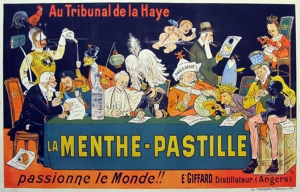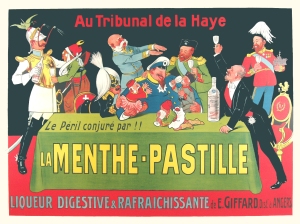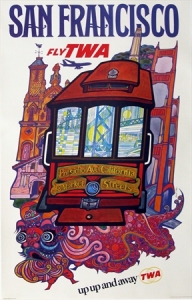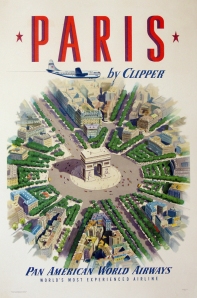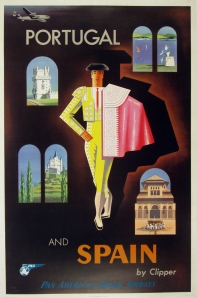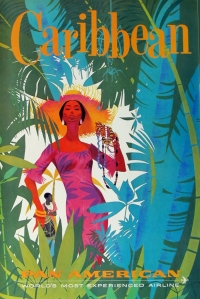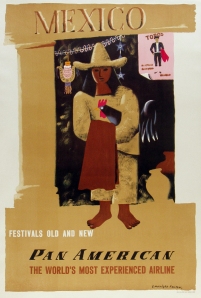Air France: French West Africa and Extrême Orient
August 14, 2016 § Leave a comment
After World War Two commercial air travel was, for the first time accessible to the public. Wartime technological advancements including radar and improvements in engineering led to faster, safer, and larger planes. An adventurous traveler could now leave their continent and in less than a day find themselves on the other side of the globe. Travel posters, always a tool of mass communication, showed exotic destinations as a means of announcing, “The world is now open to all.” Air France, one of the preeminent airlines both before and after WWII, employed the poster expertly. Their routes traced a history of commerce and many were carved out through colonialism. It is interesting to look at Air France’s choices of which destinations to promote to tourists in their advertising posters and also to examine the images used to evoke adventure, exoticism and ownership.
Although the war afforded advancements in technology and global economics, other institutions, like colonialism, persisted. Many European countries held stake in colonies thousands of miles apart. The British Empire’s holdings in India, the Middle East, and East Africa are often at the forefront of people’s minds, however, France and even smaller nations like Belgium and Portugal were key colonial players. France held power in North and West Africa as well as Vietnam, Laos, Cambodia, and the Caribbean.
***
Of the Allied powers, the French suffered particular hardship during WWII. As a Nazi occupied nation and one situated on the front lines, France’s infrastructure and economy were decimated by the end of war. Despite this, companies like Air France thrived in the new postwar environment. Flights around France, Europe, and the French colonies in Africa, Asia, and the Caribbean became increasingly popular. France’s colonial presences in West Africa and the Far East or L’Extrême Orient, especially Vietnam, made travel to these locations seem exotic yet possible. Posters, like the ones below, were created to market these destinations. The posters themselves, very similar in subject matter, speak to the ethos of the time.
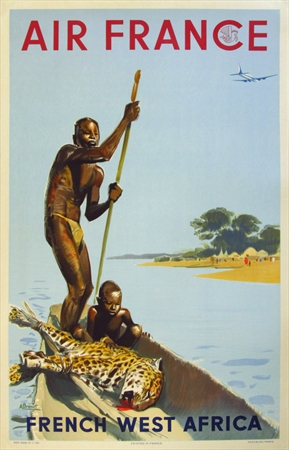
The West Africa poster was created in 1949 by Albert Brenet and shows two young men in a West African pirogue with their prey. This striking image makes references to the exotic bounty of the colony and would have grabbed the attention of any passer by.
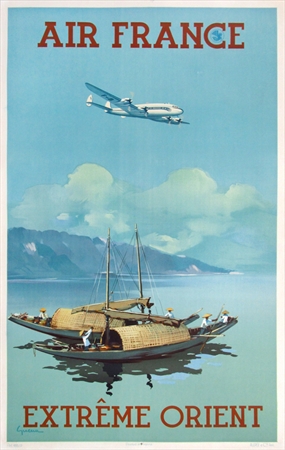
Extrême Orient by Vincent Guerra, was printed in in 1950 and features a beautiful bay and mountain scene with fishermen in their woven topped junks. The prominence of the plane shows France’s ownership of this scene as if to say “It’s ours- come explore it.” Both of these images seem to symbolize a rural, bucolic lifestyle that wasn’t quite the reality (pg. 130 Air France, https://www.scribd.com/document/54130846/The-Junk-Blue-Book). The Vietnam of the 1950s was fully embroiled in a war for its independence, first from the Japanese, then the French, culminating in the Vietnam War.
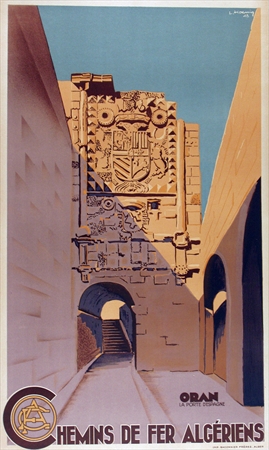
West Africa suffered similar hardships at the hand of its colonial rulers. While embroiled in bureaucratic struggles for recognition by the French Government, the native peoples of these West African nations, (Sénégal, Mali, Côte D’Ivoire, Burkina Faso, Mauritania, French Guinea, Benin, and Niger) were treated as subjects not citizens. Independence came in March of 1962 after the bloody Algerian War.
Today the colonial references on these posters are so obvious as to be almost embarrassing to the Western viewer. But they are an indelible record of the prevailing attitudes of the time period, as are all advertising posters. It’s important that they be preserved so that their messages are not forgotten.
This post was written by Susannah Starr, Summer Intern and Elizabeth Norris, Proprietor of Vintage European Posters.
Established 1997
Member IVPDA
Our Shop: 2201 Fourth Street, Berkeley Corner of Allston Way
Summer Hours Tuesday- Thursday 11-5
and select weekends
Also available by appointment
Please call 510 843 2201 or email vintageposters@vepca.com to confirm hours.
Visit our collection on the web at vepca.com
Eugene Oge and La Menthe Pastille
August 24, 2012 § 2 Comments
The greatest thing about collecting original posters is how much we get to learn about 19th and 20th century history just by soaking up these colorful collectibles. I recently found a Menthe Pastille poster by Eugene Oge which struck me as just such an opportunity to learn more about the period leading up to World War I. It is uncommon for a poster artisit to uses political humour in an advertising poster—politics can be too controversial, and might alienate the consumer from a brand, but in this example, Oge does a great job creating caricatures of the world’s leaders.
The poster from 1904 shows a total of 13 figures, each representing something different and interacting together to show political situations in Europe. They sit at a table with a tablecloth decorated with the large text of “La Menthe-Pastille.” All the figures look as if they are in peaceful talks with each other. On the left, Oge depicts William II serving a drink to the Japanese Emperor, Matsuhito. In the foreground, the Emperor of France is being comforted about his inability to produce a male heir. The Japanese Emperor stands behind the Emperor of France, even though they are enemies, but the Emperor of France does not seem concerned. In the middle of the table, the newly chosen Catholic Pope puts his arm around King Emmanuel III of Rome. Next to King Emmanuel III on the right is Edward VII, King of the United Kingdom, who smokes and gazes at the globe that the man on his right, Jacques Lebaudy, gazes at as well. Behind those two figures is Leopold II of Belguim at an image of his “muse” Cleo de Merode. Next, to the right, is Alfonso XIII who sits regally, wearing his crown, as he recently was coronated King of Spain. Lastly, below him sits Uncle Sam with a small African American baby on his lap.
In the 1913 poster, the figures are fewer, and some major players in the European situation are either out of power or not longer alive. Only 10 people now populate the poster. **Those missing are Emile Loubet, the French Emperor, and two people who had since died: Edward VII and Leopold II. The situation is much more tense here, and inflammatory situations are shown here that La Menthe-Pastille, William II tries to become allies with the Ottoman Sultan Mehmet V. In the center of the poster, the Kaiser Frederic William, plays with three small childlike figures who represent the Kings of Serbia, Bulgaria, and Greece. This poster again tells people to drink La Menthe Pastille to inject tranquility and ease into their lives, but in 1913, the statement is more adamant.
Sources
* Eugene Oge: Affichiste , Anne-Claude Lelieur et Raymond Bachollet, published 1998 by Agence Culturelle de Paris. p. 214-215)
** Eugene Oge: Affichiste , Anne-Claude Lelieur et Raymond Bachollet, published 1998 by Agence Culturelle de Paris.pages 224-225)
This post was written by Karlie Drutz, San Francisco State Museum Studies Student and VEP intern and Elizabeth Norris, Owner, Vintage European Posters.
See our entire collection of original vintage posters from Europe and the United States at www.vepca.com or visit us on Tuesdays or by appointment at our Berkeley Showroom 2201 Fourth Street in Berkeley, CA
Advertising the “Modern” Woman, A nod to Helen Gurley Brown
August 14, 2012 § 1 Comment
Something that has fascinated us recently here at Vintage European Posters is advertising’s need to be current, both of the times and ahead of the times. Graphic artists therefore must be on the cutting edge of design and modernity. They aren’t hired because they embody last year’s flavor, they’re hired because they know what’s coming next. We see this especially with posters that feature women, not just any women, but “today’s women.”
At the end of the 19th century, it was common for artists like Jules Cheret (our favorite granddaddy of vintage posters) to feature “modern” and independent women. Even the color of their hair was modern, for in 1898, when this poster was printed, women were just starting to dye their hair. Originally, red or colored hair was the mark of a fast woman, and only at the turn of the century did it become a sign of a “liberated” woman. La Diaphane features 1890’s ‘it girl’ Sarah Bernhardt endorsing rice powder .
A quarter of a century later, this poster advertising Cycles de Dion-Bouton shows a new modern woman, complete with a short bob hairstyle, and a skirt that scandalously falls above the ankles. She is modern, liberated, and fashionable, and she’s chosen the modern bicycle as her method of transportation.
This bikini-clad bombshell in Stan Galli’s Las Vegas travel poster embodies the independent woman of the 1950’s. In what is generally considered a quite conservative decade, this modern woman is scantily clad, enjoying the “day time sun” and looking forward even more to “night time fun.”
As the 20th century came to a close, so too did the century most noted for the western woman’s liberation. From suffrage rights to Betty Friedan’s The Feminine Mystique and Helen Gurley Brown’s Sex and the Single Girl , no other century has seen such dramatic change in women’s lives. This last poster, designed by the prolific poster artist Rene Gruau, shows a woman not only fashionably liberated, but sexually liberated as well.
It is perhaps the advertising poster, more so than any other popular art form, that can illustrate what is au courant, from must have modern appliances to modern fashion, from modern automobiles to the modern, liberated women.
Written by Emily Jackson, media intern &
Elizabeth Norris, owner
Vintage European Posters
Founded 1997
2201 Fourth Street
Berkeley, CA 94710
510 843 2201
TWA, On The Cutting Edge of Design
August 7, 2012 § Leave a comment
At our Pop-Up show this past weekend, I had the pleasure of flipping the pile for a woman who was full of stories. As we worked our way through the small pile, we came across a poster for TWA, which led us to a discussion about the TWA Terminal at JFK Airport. I had never seen pictures of it, but the client I was working with assured me that it was worth seeing. She was right.
As I began reseraching the terminal and the history of TWA’s travel posters, I was intrigued by the ways in which aviation and travel posters have changed over the years.
At the start of the 20th century when the airplane was a novel technology, most travel posters were focused on the planes themselves. It was the novelty of the technology, and the broad implications that the power of flight held both for speedy travel and military potential, that were glorified in these early posters. As aviation technology became more familiar and the flights became longer, it became increasingly important for posters to emphasize the comfort level of the planes.
Between the 1930’s and the 1960’s, travel posters began to focus more on destinations, rather than the planes themselves. This genre of destination poster saw its peak during the 1960’s, at the height of the Jet Age, and it was during this decade that architect Eero Sarrinen designed the famous TWA Terminal at JFK.
According to the architect, the curvilinear structure was meant to be an “icon of both modern air travel and modern design,” and an abstract symbol of flight. Sarrinen wanted it to be “a building in which the architecture itself would express the drama and specialness and excitement of travel,” and the curved shapes were meant to “emphasize an upward-soaring quality of line.”
So while the TWA posters of the 1960’s focused on destinations far and wide, the company chose to have the terminal glorify and honor the flight itself. Together they make a perfect pair, both destination and transportation.
The terminal was closed in 2001 after American Airlines bought out TWA, but has recently been restored to its former glory – complete with orange carpets!
The glamour of the Jet Age may have passed, but Saarinen’s beautiful building lives on in memory of an age when boarding a plane was an event and advertisements for TWA were pure works of art.
Written by Emily Jackson, Media Intern Vintage European Posters
Edited by Elizabeth Norris, Owner Vintage European Posters
Established 1997, Member IVPDA
2201 Fourth Street
Berkeley, CA 94710
510 843 2201
Pan Am and the Glamour of Mid-Century Air Travel
November 15, 2011 § 1 Comment
For the past five years, we have seen an incredible surge of interest in the mid-century travel posters. We have sold a lot of these posters, and it got us wondering: why are there so many mid-century airline posters?
The short answer is that the US made huge innovations in aviation technologies during World War II, and, after the war, airlines enhanced the routes. Once there were planes and hubs, it was up to advertising agencies to build the market for international travel. And voila! The posters.
Mad Men got people thinking about ad men, and Pan Am, ABC’s new Sunday night show, is going one step further, bringing to life the glamour of travel by plane in the 1960’s. We have enjoyed watching the show and couldn’t help noticing the many posters they use in their decor. So we decided to pull out our own collection of Pan Am travel posters.
Right now in our Berkeley Showroom we are featuring travel posters for destinations VEP staff have visited and loved. Come take a look and catch the travel bug!
We will be open Tuesdays and Thursdays, 11.30-5 in November — except for Thanksgiving — and the first three weekends in December.

